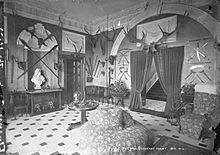
County Fermanagh is one of the thirty-two counties of Ireland, one of the nine counties of Ulster and one of six counties of Northern Ireland.

Enniskillen is the largest town in County Fermanagh, Northern Ireland. It is in the middle of the county, between the Upper and Lower sections of Lough Erne. It had a population of 14,086 at the 2011 Census. Enniskillen Castle was built in the 15th century as a stronghold of the Maguires, before coming under English control in the early 17th century. The castle and town were expanded during the Plantation of Ulster. It was the seat of local government for the former Fermanagh District Council, and is the county town of Fermanagh. The town is in a civil parish of the same name.

Earl of Enniskillen is a title in the Peerage of Ireland. It was created in 1789 for William Cole, 1st Viscount Enniskillen. He had already been created Viscount Enniskillen in the Peerage of Ireland in 1776 and had inherited the title Baron Mountflorence, of Florence Court in the County of Fermanagh, which had been created in the Peerage of Ireland in 1760 for his father John Cole, who had earlier represented Enniskillen in the Irish House of Commons. The family are descended from the Ulster planter, Sir William Cole.
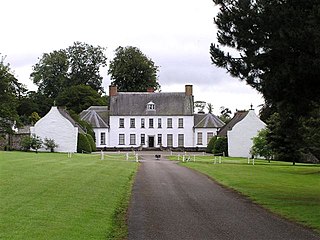
Springhill is a 17th-century plantation house in the townland of Ballindrum near Moneymore, County Londonderry in Northern Ireland. It has been the property of the National Trust since 1957 and, in addition to the house, gardens and park, there is a costume collection. It is open from March to June, and September on weekends, and is open to the public seven days a week during July and August.

John Cole, 1st Baron Mountflorence was an Irish peer and politician.

William Willoughby Cole, 3rd Earl of Enniskillen, styled by the courtesy title Viscount Cole until 1840, was an Irish palaeontologist and Conservative Member of Parliament. He also served as the first Imperial Grand Master of the Orange Order from 1866 until his death. He was Grand Master of the Grand Orange Lodge of Ireland from 1846 until his death.

Carton House is a country house and surrounding demesne that was the ancestral seat of the Earls of Kildare and Dukes of Leinster for over 700 years. Located 23 km west of Dublin, in Maynooth, County Kildare, the Carton Demesne is a 1,100 acres estate, from an original estate of 70,000 acres. For two hundred years, the Carton Demesne was the finest example in Ireland of a Georgian-created parkland landscape. In the 2000s, much of the demesne was redeveloped into two golf courses and the house into a hotel complex.

Castle Coole is a townland and a late-18th-century neo-classical mansion situated in Enniskillen, County Fermanagh, Northern Ireland. Set in a 1,200-acre (490 ha) wooded estate, it is one of three properties owned and managed by the National Trust in County Fermanagh, the others being Florence Court and the Crom Estate.
The Crom Estate is a nature reserve located in the south of County Fermanagh, Northern Ireland, along the shores of Upper Lough Erne. It is one of three estates owned and managed by the National Trust in County Fermanagh, the others being Florence Court and Castle Coole mansions. The estate comprises 1,350 acres (5.5 km2), composed primarily of riparian forest. Some trees are so ancient that physical access is restricted.
Florencecourt is a small village in County Fermanagh, Northern Ireland. In the 2001 census it had a population of 135 people. It is situated within Fermanagh and Omagh district. Historically the area was called "Mullanashangan".

Blacklion is a village in the north-west of County Cavan in Ireland. It is situated on the N16 national primary road, just across the border from Belcoo, a village in the south-west of County Fermanagh.

Donegal Castle is a castle situated in the centre of Donegal Town in County Donegal in Ulster, the northern province in Ireland. The castle was the stronghold of the O'Donnell clan, Lords of Tír Conaill and one of the most powerful Gaelic families in Ireland from the 5th to the 16th centuries. For most of the last two centuries, the majority of the buildings lay in ruins but the castle was almost fully restored in the early 1990s. It is now open to the public.
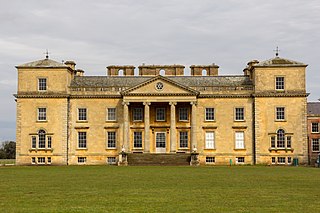
Croome Court is a mid-18th-century Neo-Palladian mansion surrounded by extensive landscaped parkland at Croome D'Abitot, near Upton-upon-Severn in south Worcestershire, England. The mansion and park were designed by Lancelot "Capability" Brown for George Coventry, 6th Earl of Coventry, and they were Brown's first landscape design and first major architectural project. Some of the mansion's rooms were designed by Robert Adam. St Mary Magdalene's Church, Croome D'Abitot that sits within the grounds of the park is now owned and cared for by the Churches Conservation Trust.

John Willoughby Cole, 2nd Earl of Enniskillen, styled Viscount Cole from 1789 to 1803, was an Irish peer and Member of Parliament.
Crom Castle is a country house on the shores of Upper Lough Erne in County Fermanagh, Northern Ireland, the seat of the Earls Erne. Standing within the 1,900-acre (7.7 km2) Crom Estate, and within a formal garden, the castle is built in stone. A central battlemented tower includes the main entrance, and there are also smaller towers to one side. It stands apart from the ruins of Old Crom Castle, of which two towers, some walls, and a ha-ha survive, and near them two ancient yew trees, believed to be at least 800 years old.
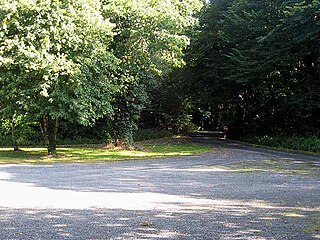
Florence Court Forest Park is a forest of Northern Ireland.

The Florence Court Yew is the surviving specimen of the two original Irish yew seedlings. As such, it is the oldest Irish yew alive and it is believed that almost all Irish yews worldwide descend from this specimen. It is located in Florence Court demesne in County Fermanagh, Northern Ireland and is cared for by the National Trust.
Belle Isle Castle is an 18th-century house on Belle Isle, an island previously known, in Gaelic times, as Ballymacmanus Island or Senadh-Mic-Maghnusa or, simply, Senad. The Belle Isle Estate stretches over 470-acres near Lisbellaw in County Fermanagh, Northern Ireland.

Townley Hall is a Georgian country house which stands in parkland at Tullyallen some 5 km west of Drogheda, County Louth in the Republic of Ireland. It was designed by Irish architect Francis Johnston for the Townley Balfour family and built between 1794 and 1798.
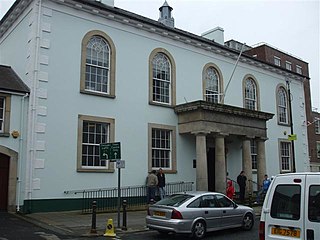
Enniskillen Courthouse is a judicial facility in East Bridge Street, Enniskillen, County Fermanagh, Northern Ireland. It is a Grade B listed building.



